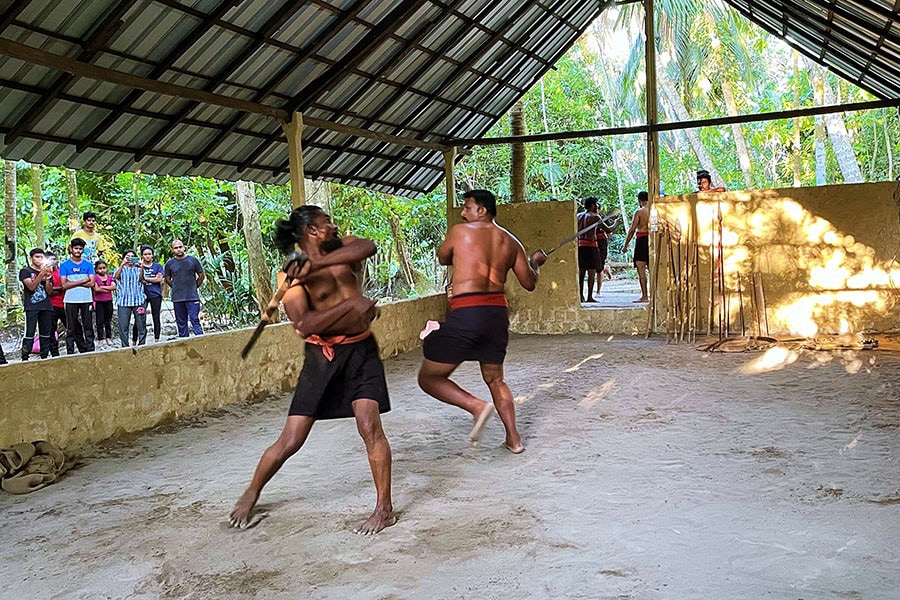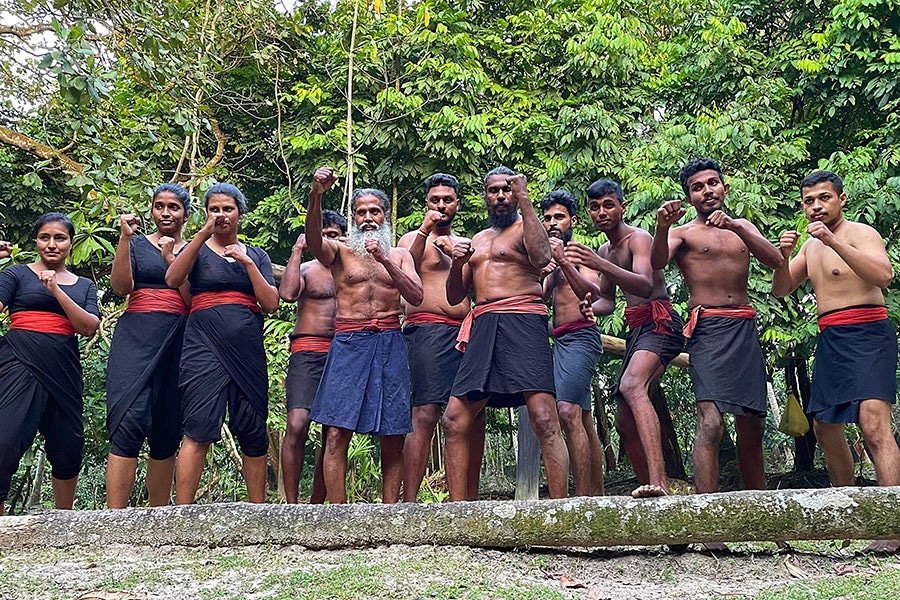Angampora, once banned in Sri Lanka, makes a comeback
After two centuries, the Sri Lankan government lifts the ban on the ancient martial art form. Legend has it that a master of Angampora could easily dominate any battlefield they set foot on


The thunderous beats of the drums ring out in a relentless rhythm, echoing through the angam maduwa (practice pit), nestled between towering coconut trees and sheltered beneath an aluminium roof. It"s a blustery afternoon, and the Angampora STIMA group has gathered at the Athurugiriya district of Colombo"s Western Province to sing paeans to a lost martial art form that had been prohibited by the British for over two centuries. There are practitioners of all ages, ranging from Guru Premasiri, 81, to Methula, a mere 12 years old.
"According to our ancestors, Angam is an art of nature. The open environment (Angam pitiya) or pit (Angam maduwa) design of the Angam has several benefits and reasons tied to the tradition and the nature of the martial art itself. The pit structure and the open-air environment provide a unique space for rigorous physical activity, enabling efficient movement and flexibility. The natural materials used, such as clay, and the thatched roof made of bamboo and coconut leaves also connect the practitioners to the earth and nature, in line with the spiritual aspects of the martial art," says Guru Piumal Edirisinghe, MD of the Sri Lankan Traditional Indigenous Martial Arts Association.
Guru Athula lights a lamp and two incense sticks for the small Buddha statue perched atop a sturdy pedestal in the far right corner of the pit. Before the practice session, everyone partakes in a silent meditation of five minutes to show reverence to their gurus, and to honour those who have taught them their craft. I watch in admiration as the male and female practitioners, dressed in their traditional diya kachchiya, solemnly swear to use the technique only in self-defence and to protect their family or country.
“This cloth, ranging from 5 to 6 feet in length and one foot in width, was ingeniously wrapped to provide a snug fit around the hips and support for the vital prana region. This design allows the Angam practitioners to move freely and gracefully while executing their intricate dance-like movements. The colours of the diya kachchiya and the red or black bands signify the gurukul (clan) that the practitioners belong to," says Guru Edirisinghe.
For close to two hundred years, Angampora was shrouded in mystery, as British colonisers in Sri Lanka (then Ceylon) had imposed a ban in 1818, perceiving it as a formidable menace. Any attempts to flout the law were met with a gunshot to the knee, virtually guaranteeing those who dared to defy it a lifetime of immobility. Despite the dire circumstances, a few families held onto the ancient martial art, preserving it for future generations.
"Of course, the only way to keep the art of Angampora alive was to disguise it as a dance. And thus, the deadly dance was born—a dance form that embodied the power of the elephant, the grace of the leopard, and the grandeur of the lion," adds Guru Edirisinghe, whose ancestors from the maternal side practised this art in secrecy during the colonial era.
Ravi and Anuruddha’s canes whir through the air like helicopter rotors, rapidly delivering blows as they engage in the ancient martial art. It reminded me of Kalaripayattu from Kerala that shares more than a passing resemblance with Angampora. Both martial arts offer a comprehensive combat system encompassing everything from powerful strikes to intricate locks, takedowns and pressure points.

Angampora is renowned for its trademark manoeuvres combining hand-to-hand combat and Illangam.
In Sri Lanka, "Angam" means the body, and "Pora" means combat with the use of limbs and without the use of weapons. It"s an art so comprehensive that it"s broken down into four categories: Guti Harammba (striking techniques), Pora Harammba (take-downs and wrestling), Gata Harammba (locking and gripping), and Maru Kala (knowledge of pressure points). Nilmini displayed locking and gripping techniques, whereas Nishantha and the others followed suit with striking with various weapons.
“In total, there are 64 types of weapons, including 32 sword variants. Students also learn a special ayurvedic practice, beheth pÄrawal, which reverses the effects of powerful strikes. The Helankada Mangalya is the grand finale of an Angampora fighter"s life and is held in a traditional Buddhist temple. The most esteemed position in Angampora is the Panikkirala or fencing master, who heads a particular school," says Nishantha.

In June 2022, the Sri Lankan government finally saw light and lifted the ban on Angampora.
Guru Athula and guru Lasantha then took the stage, showcasing their hand-to-hand combat, stick fighting, and warrior yoga skills. The hand-fighting technique known as amaraya takes Angampora training to a whole new level. Besides, with a wide range of weaponry to choose from—such as the suruttuwaluwa/velayudaya (a four-piece metal apparatus with sharp edges), the combat sword, keti kaduwa (a short sword), and cane sticks—the practitioners are prepared to face any obstacle. The arena of battle is predetermined—the pit is called Angam maduwa and the outdoor ground is called Angam pitiya.
“It"s not just about mastering the physical—to be a true martial arts master, it"s essential to understand the philosophy behind the punch and the kick. Arm yourself not only with the ability to fight, but also with the wisdom to know when, and how, to use it. Martial arts is more than just learning how to fight, it"s about learning how to live," says Guru Premasiri.
Mastering the intricate locks of Angam is a challenge for any practitioner, as they must learn to navigate diyaballu gataya, kathira gataya, lin gataya, pimburu gataya, hasthi gataya, wanda gataya, and konda gataya. Whereas unleashing offensive strikes requires mastery of techniques like dik gutiya, cholle, tokke, len pahara, miti pahara/miti gutiya, miti guliya, veesi pahara, athul pahara, pita pahara, and thallu pahara. Mayaangam, consisting of spells and incantations, was also once used.
Guru Athula, 40, asserts, “There is written evidence that Angampora has been around for over 5,000 years, thus making it one of the oldest martial arts in the world. Rana Ravana, a mythical warrior said to have lived in 5 BC, is hailed as the most fearsome Angam warrior ever to have existed."
Angampora is renowned for its trademark manoeuvres combining hand-to-hand combat and Illangam. But what makes Angampora truly infamous is its precise pressure point attacks that can make one"s opponent suffer immense pain and even be paralysed. The group then demonstrated a combination of striking and grappling techniques to trap their opponents in a submission lock that they simply couldn"t escape.
"Gaining expertise in a single weapon may take an average of three years however, to become a master of the ancient art of Angam, including both Angampora and Ellangampora, you"d have to practice for at least 15 years, with no end in sight. But now, for the first time ever, STIMA is introducing a grading system for Angampora practitioners, ranging from beginner to instructor level and comprising 12 distinct ranks," says Guru Edirisinghe.
As the practice session draws to a close, Guru Edirisinghe urges the world to recognise the cultural significance of Angampora. He says, "Angampora is more than just a martial art, it"s a deeply-rooted part of Sri Lankan culture. By learning it, you"re also immersing yourself in a rich tapestry of history and tradition. Practising Angampora improves agility, strength, and endurance. It"s also a great way to enhance concentration and mental discipline. The techniques you learn in Angampora can be practical for self-defence."
In June 2022, the Sri Lankan government finally saw light and lifted the ban on Angampora. Acting fast, the sports ministry jumped at this opportunity to promote Angampora as a valued part of the country’s heritage.
First Published: May 20, 2023, 10:12
Subscribe Now